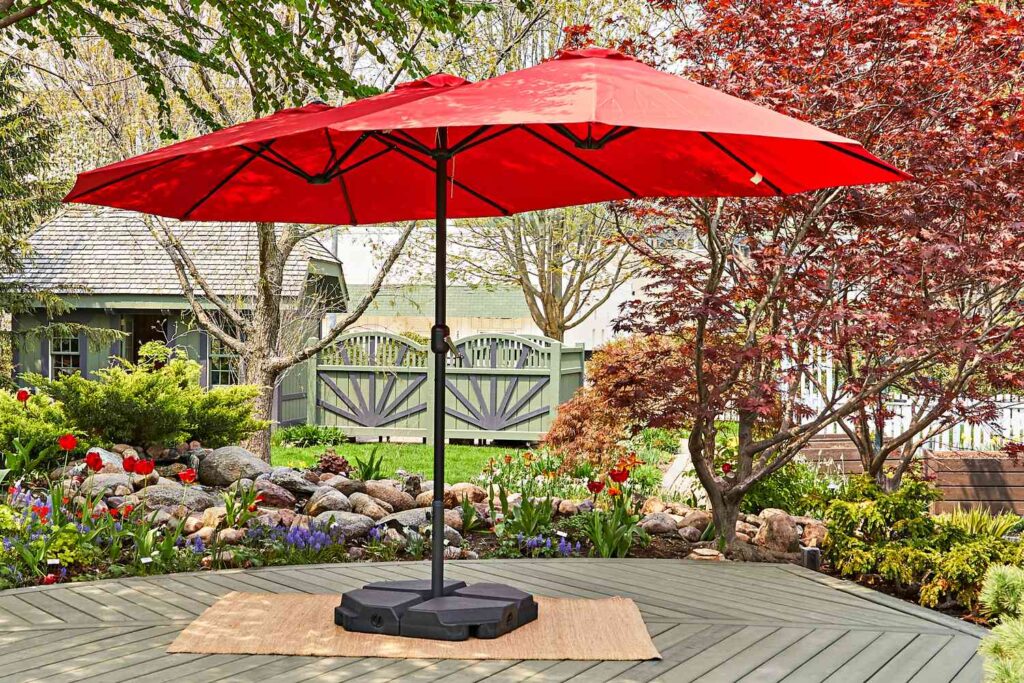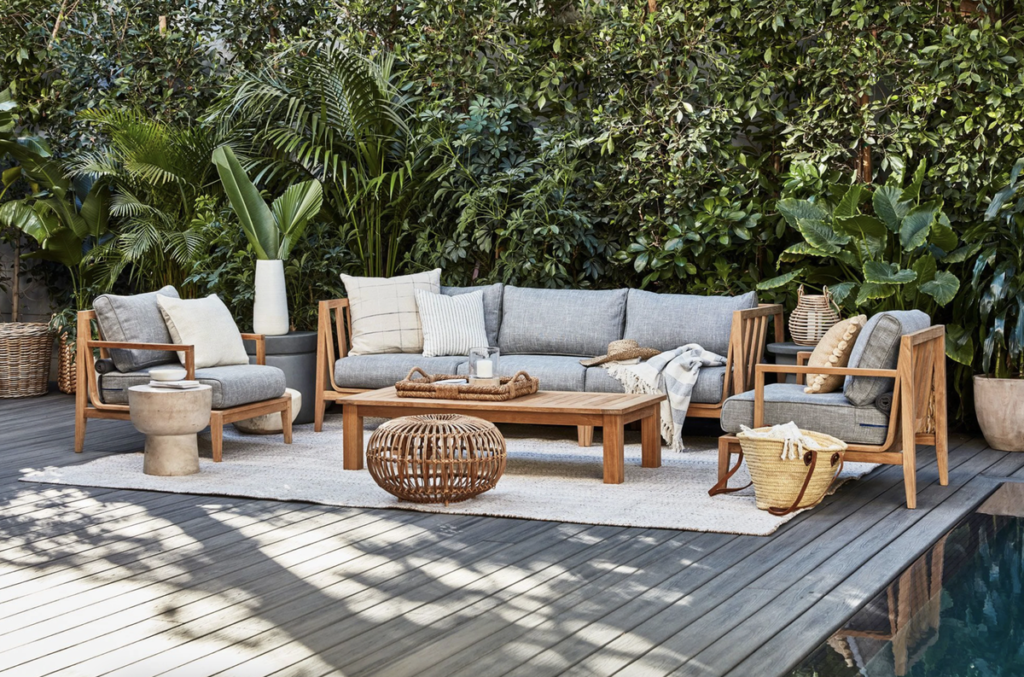Definition of Patio Umbrellas
When it comes to outdoor relaxation, few things beat lounging under the shade of a patio umbrella. These handy accessories come in a wide variety of sizes, shapes, and styles, and are essential for protecting you and your loved ones from the sun’s harmful rays. In this article, we’ll explore the different types of patio umbrellas available on the market, including their features, specifications, and capabilities. Whether you’re looking for a wind-resistant umbrella, a cantilever option, or a market-style canopy, we’ve got you covered!
Different Types of Patio Umbrellas
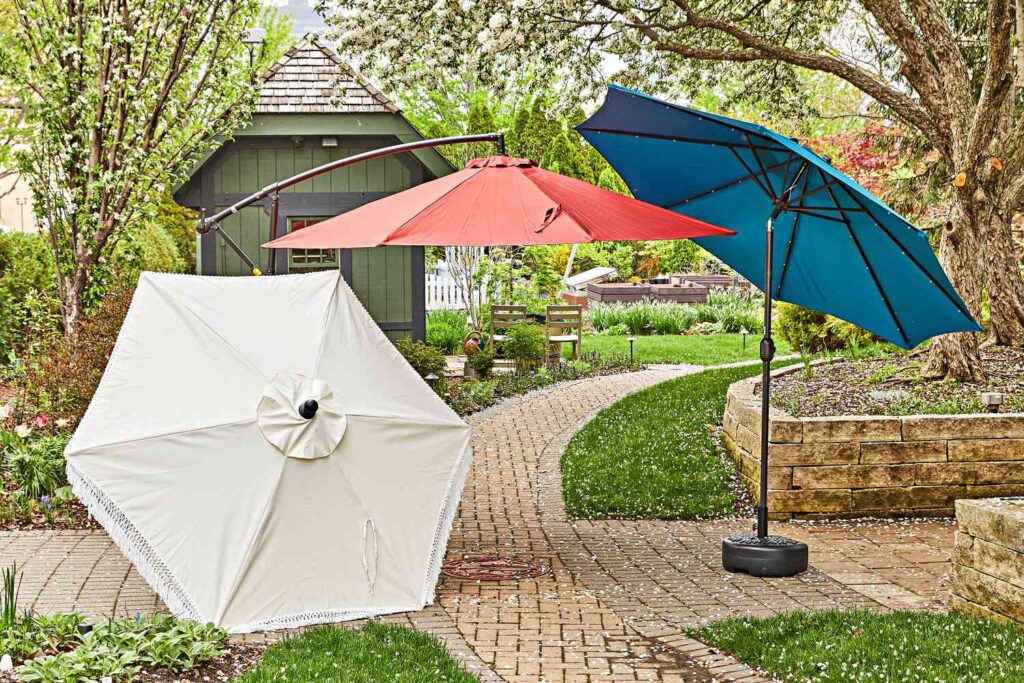
When it comes to choosing a patio umbrella, there are plenty of types and styles to choose from. Each type has its unique features and advantages that cater to different needs. Here are some of the most common types of umbrellas that are available for customers:
1. Market Umbrella
One of the most popular types is the market umbrella. These umbrellas are typically placed in the center of a table and provide ample shade to outdoor diners. They come in a variety of colors and styles, with a traditional look and feel. Market umbrellas often feature a crank mechanism for easy opening and closing.
2. Cantilever Umbrella
Cantilever umbrellas are a versatile option that provides a lot of shade without the need for a pole in the center. They have an offset base and can be placed to the side of the patio furniture. This design allows for more space under the umbrella for lounging or dining.
3. Sail Umbrella
A sail umbrella offers a unique and modern look to any outdoor space. These umbrellas are comprised of a large canopy that is stretched between multiple anchor points, creating an elegant and flowing design. Sail umbrellas are also known for their ability to protect against winds and rain due to their tight installation.
4. Wall-mounted Umbrella
A wall-mounted umbrella is a great option for smaller outdoor spaces, such as balconies or decks. They are attached directly to a wall or post and can be adjusted to cover the desired area. These umbrellas often feature special tilting mechanisms that allow for easy adjustability.
5. Tiki Umbrella
Transport your patio to a tropical paradise with a tiki umbrella. These whimsical umbrellas can be freestanding or mounted in the center of a table. They are typically made of thatched material for a fun and festive look, adding ambiance and charm to your outdoor space.
No matter what outdoor space you want to transform, there is an umbrella for you. By considering the different types of patio umbrellas available and their individual features, you’ll be able to find the perfect style to suit your needs.
Factors to Consider when Choosing a Patio Umbrella for Windy Conditions
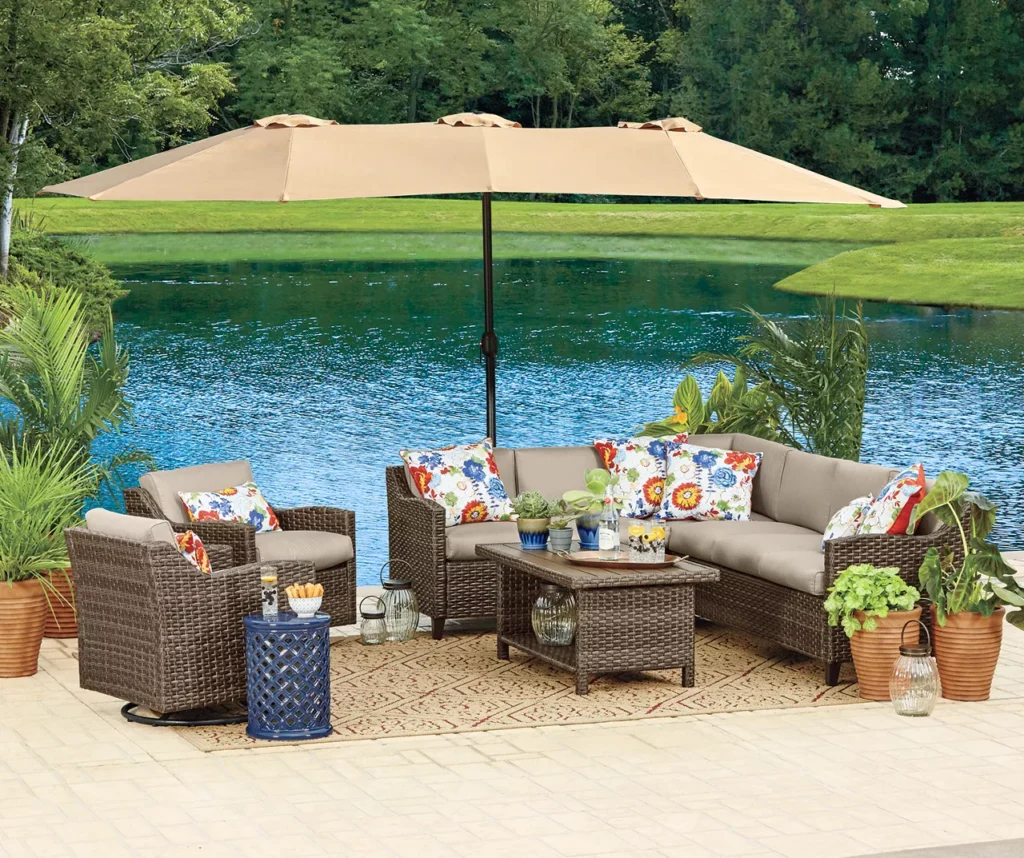
When it comes to selecting an umbrella for a windy outdoor area, several factors should be considered to ensure maximum durability, safety, and protection. From the size and shape of the umbrella to the materials used, weight capacity, sun protection, tilt mechanism, and design aesthetics, each aspect plays a crucial role in determining which patio umbrella is the best fit for windy conditions. In this section, we will explore each factor in detail and help you make an informed decision that satisfies your needs and preferences.
Size and Shape of the Umbrella
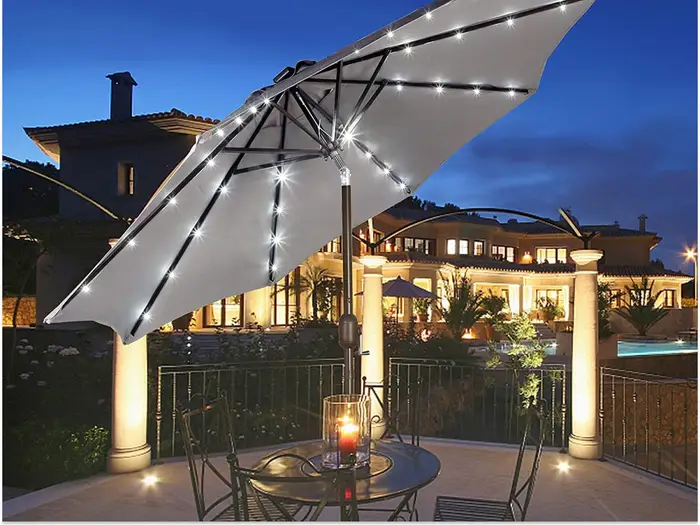
One of the most important aspects of selecting a patio umbrella for windy conditions is ensuring that the size and shape are appropriate for the outdoor area. In windy conditions, a larger umbrella will have a greater surface area to contend with, making it more difficult to keep stable. Therefore, it is important to choose the appropriate size based on the seating area you wish to cover. Always measure the area where the umbrella will be placed and ensure that the dimensions align with the seating area. This will help prevent your patio umbrella from tipping over or becoming damaged in high wind conditions.
One common type of patio umbrella that pairs well with a patio table and chairs is a market umbrella. These umbrellas come in a full selection of range of styles, making it easy to find one that fits your aesthetic preferences. They are also cost-effective and offer a variety of features, making them a popular choice for many homeowners.
Another popular umbrella style is the cantilever or offset umbrella, which features the pole on the side, rather than underneath. These umbrellas are great for poolside lounge chairs or wide radius porches because they provide ample shade without getting in the way of other outdoor activities.
Umbrella shape can also play a role in selecting the appropriate patio umbrella for windy conditions. Octagonal, rectangular, or square umbrellas are all options, but it is important to consider functionality as well as style. For example, while a square umbrella may look great, it may not provide as much coverage as an octagonal or rectangular umbrella with similar dimensions.
By considering the appropriate size and shape of your patio umbrella, you can be sure that it will provide ample shade and protection, without becoming unstable in windy conditions. So, choose wisely and enjoy your outdoor space, even on windy days!
Materials Used
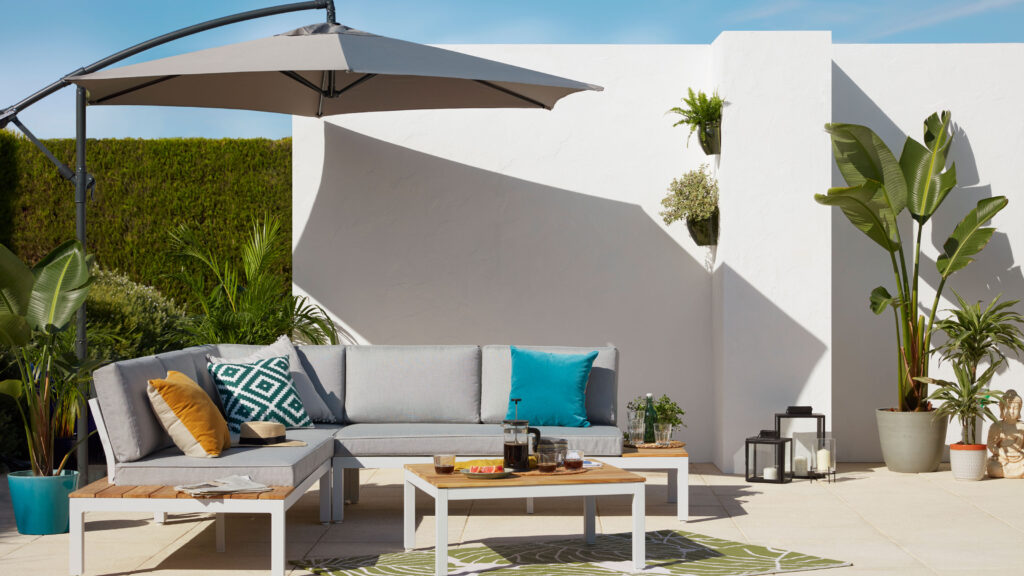
When it comes to selecting the perfect patio umbrella, the materials used for both the frame and canopy play a vital role in determining its overall durability, weight, and appearance. There are a variety of materials available for both components, each with their own advantages and disadvantages.
Aluminum is a popular material for umbrella frames due to its strength, durability, and lightweight nature. It is resistant to rust and corrosion, making it an ideal choice for areas with high moisture or rainfall. An aluminum frame also gives the umbrella a modern and sleek appearance, perfect for contemporary outdoor spaces. However, aluminum can be expensive and may not have the same natural look as other materials.
Wooden frames offer an elegant and natural look, making them a great choice for classic or traditional outdoor spaces. They can be made from a variety of wood types such as teak, pine, and cedar. However, wooden frames are heavier than aluminum frames and can be prone to warping or rotting if not properly maintained. They may also require more effort to maintain than other materials in order to keep their appearance looking top-notch.
Steel frames are among the most durable options for patio umbrellas. They typically feature a powder-coated finish to resist rust and corrosion, making them suitable for areas with harsh weather conditions. Steel adds weight to the umbrella, making it less likely to tip over in windy conditions. However, heavy steel frames can be more difficult to move around and may not offer the same modern aesthetic as materials like aluminum or fiberglass.
Fiberglass frames offer a lightweight and flexible option for patio umbrellas. They are known for their resistance to wind gusts and are a popular choice for umbrellas that will be placed in breezy areas. They also have a sleek and modern appearance, perfect for a contemporary outdoor space. However, fiberglass frames can be more expensive than other materials and may not have the same natural look as wood.
The canopy material is also an important factor to consider when selecting a patio umbrella. Sunbrella is a popular material choice for canopies due to its resistance to fading, stretching, and water damage. Sunbrella canopies are available in a wide range of colors and patterns, making it easy to find a style that matches your outdoor space. However, Sunbrella canopies can be more expensive than other fabric options, and may not be as breathable as other materials.
When selecting the right patio umbrella material, consider the location, climate, and style of your outdoor space. Each material offers its own set of pros and cons, and understanding your needs and preferences will help ensure you select the perfect patio umbrella for your outdoor oasis.
Weight Capacity
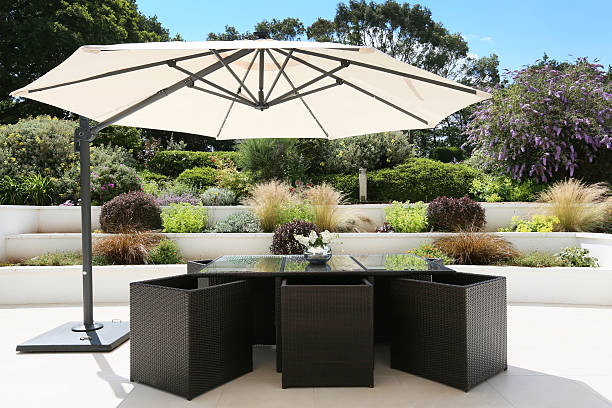
Choosing the correct weight capacity for your patio umbrella is crucial to ensure that it stays stable and secure. An umbrella that is too light in weight for its size and shape can easily tip over, causing damage or injury to people and property. On the other hand, an excessively heavy base may not be necessary and can be difficult to move when needed.
When determining the weight capacity required for your patio umbrella, consider the size and shape of the canopy, as well as the materials used for the frame and canopy. Additionally, the weather conditions in your area should also be taken into account. If you live in an area with high wind gusts or frequent storms, a heavier base may be necessary to keep your umbrella secure.
There are several types of bases available for patio umbrellas. Stone, iron, and concrete bases are popular choices due to their durability and longevity, but they can be heavy and difficult to move. Less expensive options include plastic bases that can be filled with sand or water, providing a good amount of weight without sacrificing portability.
When it comes to market umbrellas, it is important to follow weight guidelines provided by the manufacturer. A standard 9-foot umbrella typically requires a base weight of at least 50 pounds, while larger umbrellas may require up to 100 pounds or more depending on the size and shape of the canopy. Following these guidelines will ensure that your patio umbrella remains stable and secure in all weather conditions.
In conclusion, selecting the correct weight capacity for your patio umbrella’s base is essential to ensure stability and safety. Taking into account the size and shape of your umbrella, materials used, and local weather conditions, as well as selecting an appropriate base, will ensure that your patio umbrella provides ample shade and shelter for years to come.
Protection from the Sun and Weather Elements
When it comes to choosing the best patio umbrella for windy conditions, it is important to consider protection from the sun and other weather elements. A good patio umbrella not only provides ample shade but also acts as a barrier from harmful UV rays. This is where UPF ratings come into play. UPF ratings measure a fabric’s ability to block ultraviolet radiation. The higher the UPF rating, the better the protection provided.
Fabrics like Sunbrella and other acrylics are known for offering excellent UPF ratings, with values of UPF 50+. These fabrics are designed to withstand the harsh rays of sunlight and provide much-needed protection for those sitting underneath the umbrella. Choosing a fabric with a high UPF rating is particularly important for those who spend long hours outdoors, such as during outdoor parties or events.
However, protection from the sun is not the only thing to consider when choosing a patio umbrella for windy conditions. It is also important to choose a sturdy stand that can keep the umbrella in place during gusty winds. A sturdy stand can prevent the umbrella from tipping over and causing damage or injury.
When choosing a stand, it is important to ensure that it can grab onto the umbrella pole firmly and securely. A good stand should be able to grab onto the pole at least a foot high without biting into the umbrella’s material. This ensures that the umbrella stays in place, even during windy conditions.
In conclusion, protection from the sun and other weather elements is an essential consideration when choosing a patio umbrella for windy conditions. Selecting a fabric with a high UPF rating like Sunbrella or other acrylics, and choosing a sturdy stand that can keep the umbrella in place during gusty winds, ensures that you and your guests can stay protected and enjoy your outdoor space comfortably.
Tilt Mechanism
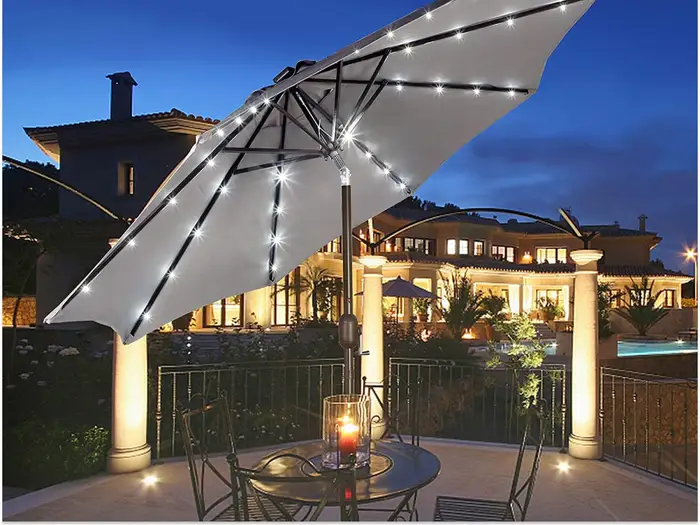
Tilt functionality is an important aspect to consider when choosing a patio umbrella. It allows users to adjust the angle of the umbrella to block the sun from different directions and provide more shade and protection. There are various types of tilt mechanisms commonly used in patio umbrellas, each with its own set of advantages and disadvantages based on ease of use, range of motion, and degree of adjustability.
The most common types of tilt mechanisms are push-button, crank, and collar tilt. Push-button tilt mechanisms are typically easy to use and offer a decent range of motion and degree of adjustability. They utilize a button that users push to tilt the umbrella, and they can be set at different angles to accommodate changing sun positions. However, push-button tilt mechanisms may not offer the most precise adjustments to the angle of the umbrella.
Crank tilt mechanisms require users to turn a crank handle to tilt the umbrella. They offer a high degree of adjustability and range of motion, making them a great choice for those who want complete control over the positioning of their umbrella. However, they may be more difficult to use and require more effort than push-button tilt mechanisms.
Collar tilt mechanisms use a collar that users rotate to tilt the umbrella. They offer good adjustability and range of motion, but they may not be as easy to use as push-button mechanisms. Collar tilt mechanisms typically require users to hold the umbrella pole in place while turning the collar, which may be challenging for some users.
In conclusion, tilt functionality is an essential consideration when choosing a patio umbrella as it provides sun protection from various directions. It is important to choose a tilt mechanism that is easy to use and offers the desired range of motion and degree of adjustability. Push-button, crank, and collar tilt mechanisms are the most common types of tilt mechanisms, each with its own set of advantages and disadvantages.
Design Aesthetics
Design aesthetics are an essential aspect to consider when selecting a patio umbrella. The design and color of the umbrella can either complement or contrast the overall theme of the patio, greatly enhancing its overall look and feel. The key is to ensure that the patio umbrella’s design and color scheme seamlessly blend in with the surrounding environment, creating an attractive and harmonious outdoor space.
Choosing a color and design pattern that appropriately matches or contrasts with the surrounding environment is crucial in creating an aesthetically pleasing patio. For instance, a blue patio umbrella could accentuate a pool area, while a brighter color could add a pop of vibrancy to an otherwise plain patio. On the other hand, choosing a neutral color with a simple design pattern could create a sense of sophistication and elegance.
General practices that homeowners follow when selecting the right color and design pattern for their patio umbrella include determining the predominant color scheme of the outdoor area, considering the shape and size of the umbrella, and picking a pattern that complements the overall style of the patio furniture. It’s essential to keep in mind that the color and design must not clash with the overall aesthetic of the patio.
It’s worth noting that aesthetics is a subjective topic, and ultimately the decision lies with the user’s preference. It’s important to select a design and color that appeals to one’s style and personality, as it is ultimately what makes them happy and comfortable in their outdoor space. The key is to ensure that the umbrella’s design and color scheme create a cohesive and visually pleasing outdoor space.
In conclusion, design aesthetics play a vital role in choosing the right patio umbrella. A well-placed and carefully chosen patio umbrella can enhance the outdoor ambiance, adding an extra layer of relaxation and enjoyment to one’s time spent in the fresh air. By following general design practices, selecting a color and design pattern that complements or contrasts appropriately with the surrounding environment, and considering one’s personal preferences, an aesthetically pleasing patio can be achieved.

